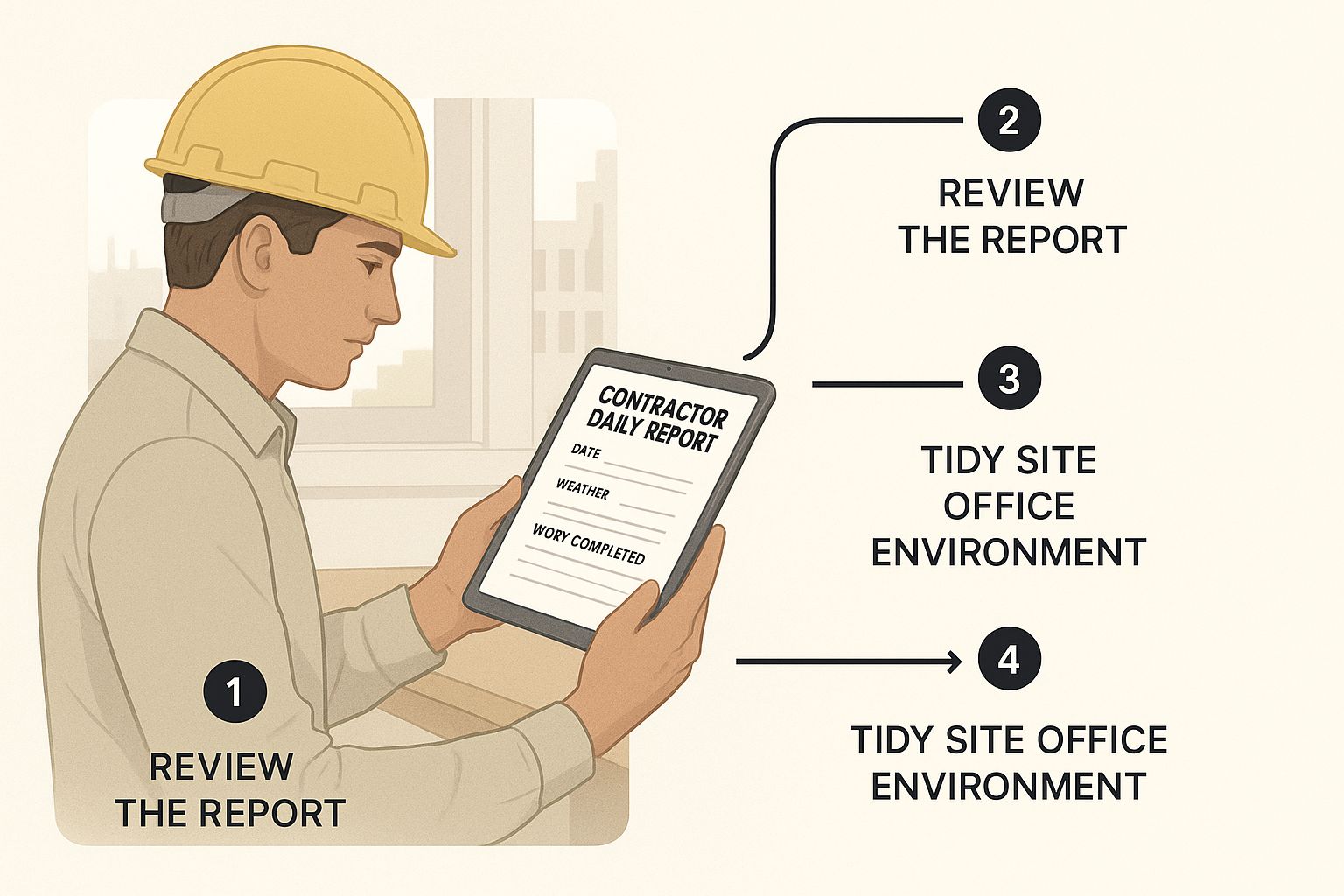A solid contractor daily report template is your project's official diary. It’s the single source of truth that keeps communication clear, cuts down on arguments, tracks real progress, and ultimately, protects your business. This isn't just about filling out a form; it's about building an undeniable, day-by-day record of what actually happened on site.
Why a Daily Report Is More Than Just Paperwork
It’s easy to see daily reports as just one more tedious task to slog through at the end of a long, exhausting day. I've been there. But shifting your perspective is key. A well-kept daily log is one of the most powerful tools in your arsenal. It’s the official story of your project, told one day at a time.
Think about this real-world scenario: a client questions a change order, insisting the extra work couldn't have taken more than a few hours. A lazy report that just says "Worked on change order" isn't going to help you. It’s your word against theirs.
Now, imagine your report reads: "Installed 3 additional circuits for new office layout per Change Order #004. Crew of two electricians on-site from 1 PM to 5 PM. Used 250 feet of 12-gauge wire." That kind of specific, detailed entry provides concrete evidence, protecting your invoice and, just as importantly, your professional reputation.
The Foundation of Project Success
This document is your bedrock for clear communication and legal protection. It creates a transparent, chronological history that keeps everyone on the same page, from the superintendent right up to the client.
Good daily reporting really pays off in a few critical areas:
- Dispute Resolution: It gives you a factual, time-stamped record to shut down disagreements over work performed, delays, or on-site incidents.
- Progress Tracking: By logging daily wins, you can see at a glance if the project is on track, or if you’re starting to fall behind schedule.
- Resource Management: It helps you keep tabs on labor hours, equipment usage, and material deliveries, which is crucial for optimizing how you use your resources on the next phase of the job.
This isn't just about covering your backside. It's about smart, proactive project management. A consistent daily log will show you patterns—maybe one piece of equipment is always down, or a certain supplier is chronically late. Spotting these trends lets you fix the small problems before they blow up into major ones.
Building an Undisputed Record
At its heart, the daily report is all about creating an unchallengeable account of the day's events. Using a standardized contractor daily report template is what makes this documentation both consistent and complete.
When your whole team uses a structured format, you dramatically lower your risk and are far less likely to have quality control issues pop up. This discipline helps you stick to your schedule and your budget. It also lets you analyze manpower data, track hours by trade, and measure your actual progress against your goals, boosting the entire project's performance. You can see how structured reporting transforms project outcomes and get more insights on the topic.
By making this process a priority, you stop being a passive record-keeper and start actively steering your project toward a successful finish.
The Anatomy of a Great Contractor Daily Report
If you're building a daily report template from scratch, it's easy to get overwhelmed. The trick is to stop thinking of it as one giant form. Instead, picture it as several key sections, each telling a vital part of the daily story on your job site. A truly solid template goes way beyond a few blank lines; it creates a bulletproof record that keeps everyone on the same page and protects you legally.
Think of it like this: a well-designed template is a roadmap for your site supervisor, guiding them through a complete and efficient review of the day's events.

When the information flows logically—from the basic project details to the nitty-gritty of daily work—the whole process becomes faster and more intuitive for the person filling it out in the field.
To get this right, you need to include several non-negotiable components. These elements are the building blocks of a report that provides real value, moving from high-level project info down to the critical details of daily operations.
Essential Components of a Contractor Daily Report
Here’s a breakdown of the critical sections every daily report template should have. Think of these as the absolute must-haves for creating a clear, comprehensive, and legally sound document.
Getting these sections right turns a simple daily task into a powerful project management tool. It ensures nothing falls through the cracks.
Beyond the Basics: Adding Actionable Detail
Let's dive a little deeper into a few of these areas.
Documenting Site Conditions and Weather
The environment dictates so much of what can (and can't) happen on a construction site. A sudden thunderstorm can turn an excavation pit into a muddy mess, high winds can shut down crane work, and a cold snap can ruin a concrete pour.
That’s why your template needs to capture more than just "cloudy." Prompt your team for specifics:
- Temperature range (high and low)
- Precipitation (and how much)
- Wind speed
- General ground conditions (e.g., "muddy," "frozen," "dry")
This level of detail creates a factual record that becomes your best friend when you need to explain weather-related delays.
The "Big Three": Labor, Equipment, and Materials
This section is the heart of your daily report—it’s where you track your biggest costs. Vague entries here are a recipe for disaster. Your template has to force your team to be specific.
For labor, forget just listing names. Break it down:
- Subcontractor/Trade: Group crews by company (e.g., ABC Plumbing, XYZ Electric).
- Worker Count: How many people showed up for each trade.
- Hours Worked: The total hours that crew logged.
- Work Description: A clear, simple summary of what they actually did.
The same goes for equipment. Note the machine, how many hours it ran, and any downtime. For materials, log every delivery, the quantity you received, any damaged goods you had to reject, and who sent it.
A great report is a complete daily snapshot. It documents everything from who visited the site to what roadblocks you hit. This detail proves what happened, who was there, and what stood in your way.
Weaving Safety into the Daily Routine
A safe site is a productive site, and your daily report is the best place to document your safety efforts proactively. Having a dedicated section for safety encourages your foremen to constantly be on the lookout for both good practices and potential hazards.
This is also where you can connect your daily reporting to broader compliance. For example, knowing the key parts of an OSHA Emergency Action Plan template can help you structure this section to report on critical safety measures effectively. Documenting daily toolbox talks or noting that a worker was missing their PPE creates a powerful, continuous record of your commitment to keeping everyone safe.
It's Time to Ditch the Paper Logs for Good
Let's be honest—relying on crumpled paper logs and messy spreadsheets for daily construction reports is a thing of the past. While these old methods might feel familiar, they're painfully slow, filled with potential errors, and often create frustrating information gaps that can bring a project to a grinding halt. The real work is moving to tablets and phones, right where the action is.
Making the switch to a smart, cloud-based contractor daily report template isn't just about "going digital." It’s about completely overhauling how your project runs, unlocking a level of speed and accuracy that paper and pen could never touch.
Just look at how a modern construction daily report app presents information. It’s clean, simple, and built for the field.

The best tools are designed for quick taps, not tedious typing. A foreman can log labor hours, equipment usage, and progress in a few moments. This is what changes everything: your daily report transforms from a historical record into a live, real-time project management powerhouse.
Using Tech for Smarter Data from the Field
Modern reporting software takes the grunt work out of the equation. Picture this: your report automatically logs the day's weather—temperature, humidity, precipitation—without anyone lifting a finger to look it up. This doesn't just save a few minutes; it provides precise, verifiable data to back you up if you face weather-related delays.
But it gets even better. Here are a few other game-changing features:
- Instant Photo and Video: A picture says it all. Crews can snap and attach time-stamped photos or videos to document progress, flag a safety issue, or show proof of an unexpected site condition.
- Offline Functionality: Let's face it, job site Wi-Fi is rarely reliable. Good apps let your team fill out the entire report offline and then sync it automatically as soon as they get a signal. No more lost data.
- Automated Data Logging: Beyond weather, these systems can often link with other tools to pull in equipment usage stats or maintenance alerts, adding another layer of rich, accurate data to the daily log.
As you explore digital tools, don't overlook how effective speech-to-text for Windows applications can be. It allows your team to dictate detailed notes quickly and easily, capturing more context with far less effort.
The real goal here is to get high-quality information from the field to the office with as little friction as possible. When you free up your site supervisors from paperwork, you empower them to do what they do best: manage the project.
The Next Wave: Predictive, AI-Powered Reporting
The future of reporting is already taking shape with artificial intelligence. New AI systems can analyze all the data flowing in from your daily reports to spot patterns and flag potential risks you might otherwise miss.
For instance, an AI might notice that a specific subcontractor is consistently behind schedule or that minor safety incidents are popping up more frequently. It can then alert project managers before these small issues snowball into major problems. This is what turns a simple daily log into a predictive, strategic asset. A modern contractor daily report template, backed by this kind of technology, helps you look forward instead of just looking back.
Best Practices for Daily Reporting in the Field
https://www.youtube.com/embed/qs2HzP9Q9eg
Having a polished contractor daily report template is a fantastic start. But let's be honest—a template is just a piece of paper (or a digital form) until your team in the field puts it to work consistently. The real magic happens when daily reporting becomes an ingrained habit, not just another chore to check off. This is what builds a culture of accountability and transparency on the job site.
The whole system really hinges on three simple but non-negotiable pillars: consistency, timeliness, and objectivity.
First, these reports need to be filled out every single day. No exceptions. Even on slow days where it feels like nothing happened, documenting that is still important. A missed day creates a gap in your project's story, a blind spot that can leave you exposed if questions or disputes pop up down the line.
Second, timing is everything. Trying to recall specific details from yesterday is a recipe for fuzzy, inaccurate information. The best-run sites make it a rule: the report gets filled out at the end of the workday, while everything is still fresh in your mind. This one change can dramatically boost the quality of your data.
From Vague Notes to Clear Facts
How you write your entries is just as critical as what you include. Vague notes are the enemy of a good daily report. You need to write with absolute clarity, leaving zero room for interpretation.
For example, instead of a lazy entry like, "Poured concrete," a detailed, professional log would look like this:
- Poured 35 cubic yards of 4,000 PSI concrete for the eastern retaining wall foundation.
- Pour completed between 10:00 AM and 1:30 PM by a crew of four from ABC Concrete.
See the difference? This level of detail—with quantities, locations, times, and names—turns a flimsy note into a rock-solid factual record. It’s the shift from subjective observation to objective documentation.
Always stick to the facts. A daily report is not a diary. It's not the place for opinions, finger-pointing, or frustration. Its only job is to state what happened, who was there, and what the conditions were. A factual report is your best friend in any future negotiation or dispute.
This same objective mindset should apply to everything you document on-site. Take your equipment, for instance. A structured check-in and check-out process is crucial for safety and maintenance. You can find some great principles for building this kind of robust system by looking into best practices for implementing a daily vehicle check sheet.
Applying this disciplined, factual approach to documenting delays, safety incidents, or change orders is just as vital. When a delay happens, note the exact reason, the time it began and ended, and its impact on the schedule. For any safety incident, document the facts—what occurred, who was involved, and the immediate response. When you make these practices a habit, your daily report transforms from a tedious task into a powerful tool that protects your business and keeps your projects humming along.
Turning Daily Data into Project Insights

Let's be honest, your daily reports are more than just a checkbox exercise to prove what happened yesterday. They're a goldmine of project data. The real magic happens when you start digging into the information from your contractor daily report template. That's when a routine chore becomes a serious strategic advantage, protecting your schedule and your profit margins.
This isn't about getting lost in spreadsheets. It’s about spotting patterns. Are you seeing consistent material delivery delays from the same supplier? Are the labor hours for drywall consistently blowing past your estimate? These aren't just minor frustrations; they're clues that point you toward major operational fixes.
When you translate this raw data into real insights, your daily reporting stops being a task and starts being a tool for building a more efficient and profitable project.
Optimizing Crew and Resource Allocation
One of the quickest wins you'll get from analyzing your reports is figuring out how to better manage your most expensive assets: your crew and your equipment. Those labor logs aren't just timesheets; they're a detailed productivity map of your job site.
Think of it this way. Your report shows that the three-person framing crew is consistently wrapping up two hours ahead of schedule, while the plumbing sub is always playing catch-up. That single piece of information empowers you to make a smart move. Maybe you can shift a laborer to help the plumbers get back on track. Or, you could have a pointed conversation with that subcontractor, armed with hard data instead of just a gut feeling.
This kind of proactive resource management helps you:
- Identify Your All-Stars: Recognize which crews are knocking it out of the park so you can learn from what they're doing right.
- Spot Bottlenecks Early: See which trades are struggling before they derail the entire project schedule.
- Justify Staffing Decisions: Use historical data to confidently predict your labor needs for the next job.
Daily reports give you the hard evidence you need to shift from constantly putting out fires to proactively managing your project. The data tells a story about where you're winning and, more importantly, where you need to focus your attention right now.
Preventing Delays and Reducing Rework
The data in your daily reports is also your best line of defense against costly rework and schedule-busting delays. For instance, by simply tracking material deliveries, you can quickly identify a supplier who is always late. This gives you enough runway to find a backup before their delays impact your critical path.
The financial upside of better reporting is huge. Digital tools, in particular, can offer a massive return. One analysis found a ninefold return on investment (ROI) for companies using a digital reporting app, mostly because they cut down rework by two hours for every one hour spent on inspections. Globally, these kinds of productivity boosts from better reporting could save the industry an estimated $1.63 billion. You can dig deeper into how digital reporting tools drive these results and see the numbers for yourself.
When your reports are detailed, consistent, and easy to access, you build a system that catches problems before they snowball. A simple photo from a foreman showing an improperly installed pipe fitting, logged right in the daily report, can be corrected immediately. Without that timely, documented insight, the mistake might go unnoticed for weeks, leading to expensive demolition and rework. Your reporting system becomes an early warning signal that directly helps you stay on schedule and on budget.
Frequently Asked Questions About Contractor Daily Reports
Even with a great template, questions always come up once you start using daily reports on a busy job site. Getting straight answers to these common questions is the key to getting your team on board and making the process work. Let's dig into some of the things we hear most often from contractors out in the field.
Who Is Responsible for Filling Out the Daily Report?
On most job sites, this responsibility falls to the person leading the charge on the ground. That’s typically the site superintendent, project manager, or crew foreman.
The most important thing isn't the specific title, but consistency. When the same person or role handles the report every day, you get a consistent perspective and a uniform level of detail. It just becomes part of their daily routine.
For larger, more complex projects, you might have several foremen jotting down notes for their specific crews. If that's the case, a superintendent or PM usually steps in to compile all those updates into one master report for the day. This keeps everything organized and creates a single, reliable source of truth for the project.
How Detailed Should My Daily Report Be?
Think of it this way: could someone who has never set foot on your site read the report and get a clear picture of what happened? That's the level of detail you're aiming for. The goal is to paint a clear, factual picture that leaves no room for guesswork.
A vague report might say, "Poured concrete." A professional report would state, "Poured 30 cubic yards of 4000 PSI concrete for the west wing foundation slab from 9 AM to 1 PM."
Always try to include the specifics—quantities, locations, names, and times. This small change transforms a simple note into a solid, verifiable record. That kind of detail is gold when you're tracking progress or, heaven forbid, dealing with a dispute down the road.
Can a Daily Report Be Used in a Legal Dispute?
Absolutely. In fact, that's one of their most critical functions. Consistent, objective, and well-documented daily reports can be incredibly powerful in a legal setting.
Should a conflict arise over the scope of work, project delays, a change order, or an on-site incident, these reports become your time-stamped evidence. They provide a factual, day-by-day account of what actually happened. This is precisely why it's so important to be accurate and stick to the facts. Leave out personal opinions, assumptions, or any emotional language. The real power of your daily log lies in its objectivity.
Is Digital or Paper a Better Format?
I get it, paper is familiar. But for modern construction, digital is hands-down the better choice. A digital contractor daily report, especially when it's part of a construction management app, offers some serious advantages that paper just can’t compete with.
Here’s what you gain by going digital:
- Automated info like weather conditions gets pulled in for you.
- Instant sharing with the office, owners, and anyone else who needs to see it.
- Secure cloud storage, which means no more lost or damaged reports and easy searching later on.
- Seamless photo and video integration right into the report.
Making the switch saves a ton of time, cuts down on human error, and makes all that valuable information you're collecting so much more useful for the entire team.
Ready to stop chasing down handwritten notes and get perfectly formatted updates from the field instantly? With ResQ’s AI assistant, Nora, your team can send updates via WhatsApp using voice, text, or photos, and Nora does all the heavy lifting. See how you can transform your reporting by checking out ResQ's Nora today.



